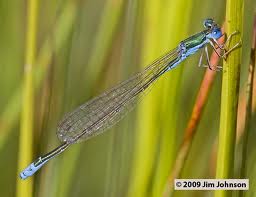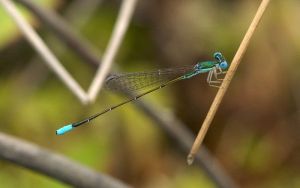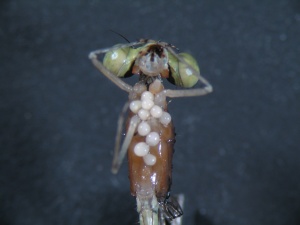I’m happy to announce that I have had another paper published called “Explaining susceptibility and resistance to a multi-host parasite”. This time it is published in Evolutionary Biology (Mlynarek et al 2013). In this paper, My co-authors and I present resistance by a damselfly to a water mite parasite. What is really interesting in this system is that the hosts very close relative, doesn’t resist this species of water mite at all.
So here’s the story. While collecting at two bog sites around the Queens University Biological Station two summers ago, I noticed that two species of damselflies were especially abundant. Nehalennia irene (sedge sprite, Fig. 1) and Nehalennia gracilis (sphagnum sprite) (Fig. 2). At one of the two sites, the sedge sprite was more abundant than its close relative the sphagnum sprite, at the other they both were equally abundant. The abundance of these two species is not what’s most interesting. What is fascinating is what it happening with the parasites. But before I go into the detail of the water mite-sprite associations, I must talk a little about the natural history of these two sprite species.
Evolutionarily, these two species are closely related, almost sister species. Both species are the same size; the sedge sprite is slightly smaller. They have very similar flight seasons; the first sphagnum sprites were caught a week after the first sedge sprites. That’s where the similarities end. The sphagnum sprite is restricted to bogs with open pools, whereas the sedge sprite is found in all, still and slowly moving, water habitats, hence it is very cosmopolitan. Probably because of this the sedge sprite, as a species, has a much larger geographic distribution than the sphagnum sprite.
With this knowledge in hand, I can talk about the water mite-sprite association. As I was collecting with my field assistant, we noticed that the sphagnum sprite resists all the water mites whereas the sedge sprite does not resist any in these two sites. When I saw this in my hand in the field, I was completely stumped. What does this mean? Why would one completely resist whereas the other didn’t? That’s what this paper is attempting to explain. First we checked the water mite morphologically that they are the same. We made sure that they are the same species using the barcode CO1 molecular marker. With very little divergence (less than 0.5%) between all the water mites barcoded, we felt confident enough to say that both sprites are parasitized by the same water mite species. In addition, to our knowledge, this mite was not found in habitats surrounding the bog, so it seems to be a bog specialist, just like the sphagnum sprite.
Now you may be asking, how we know when a water mite is resisted. We are lucky in this system because once a water mite is resisted, it remains attached to the host because the tube it has formed to feed on the host remain embedded in the host. Therefore the resisted mite remains small and actually becomes a flattened and dries up (Fig. 3). It’s not the plump happy engorging mite that can engorge several times its size (Fig. 4). When a host individual recognises the mite, it releases a clotting substance called melanin and blocks off the feeding tube from the hemolymph, the insect blood, in what can be compared to as a melanin balloon (Forbes et al. 1999).

Fig. 3 Resisted mites on Nehalennia gracilis. You can see the circular outlines between the legs (there are 8 mites on this individual).
So in this case, we have the sphagnum sprite, a species that is restricted to bogs, that resists a water mite that is also a bog specialist. What is especially cool is that this sprite seems able to get melanin, the clotting substance, into the parasite (Fig. 5). This has never been documented before! But we also have the sedge sprite, the cosmopolitan species. No individual of this species resist this mite. This is opposite to what we expect because the widespread species should, in theory, be able to recognize more parasites than a restricted species that doesn’t have that much experience with parasites outside the habitat it is restricted too. We think that is why it is important that the mite is a bog specialist as well. We, therefore, propose that the mite and the sphagnum sprite probably evolved together and through time, the sphagnum sprite developed recognition and resistance to this specialised enemy. However, the mite didn’t have to bypass the defences of the sphagnum sprite because it has the sedge sprite it can parasitize and survive on this host. What is baffling and only time will tell, is if the mite will start recognising the sphagnum sprite as the wrong host and completely switch to the sedge sprite.

Fig. 5 Slide mounted mites. On the right (A), the engorged (happy) mite from Nehalennia Irene. On the left (B), the resisted (dead) mite of Nehalennia gracilis. Notice the size difference and the darker color of the mite and the really dark spots (the melanin) around the head region.
References
Forbes, M. R., Muma, K. E., & Smith, B. P. (1999). Parasitism of Sympetrum dragonflies by Arrenurus planus mites: Maintenance of resistance particular to one species. International Journal of Parasitology, 29, 991–999.
Mlynarek, J.J., Knee, W. and Forbes, M. 2013. Explaining susceptibility and resistance to a multi-host parasite. Evolutionary Biology. DOI: 10.1007/s11692-013-9251-6.



